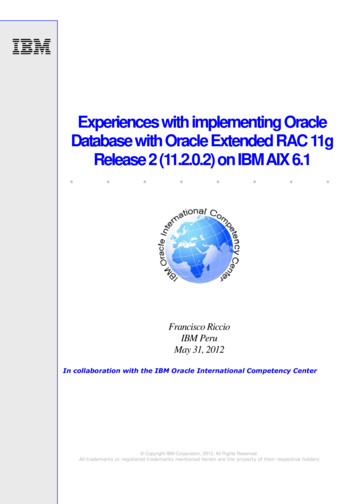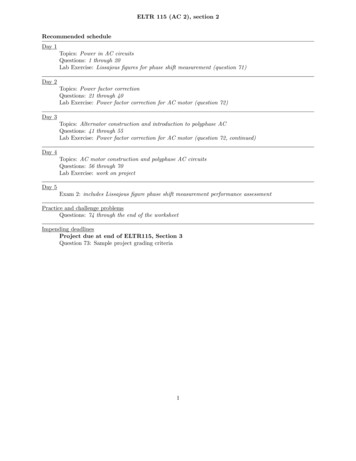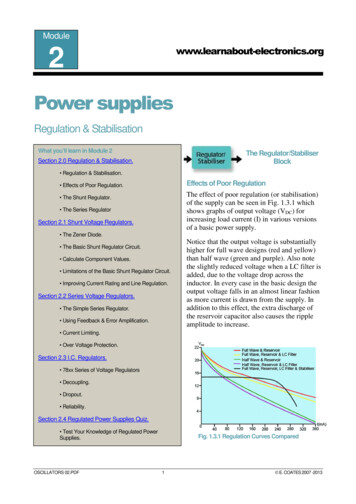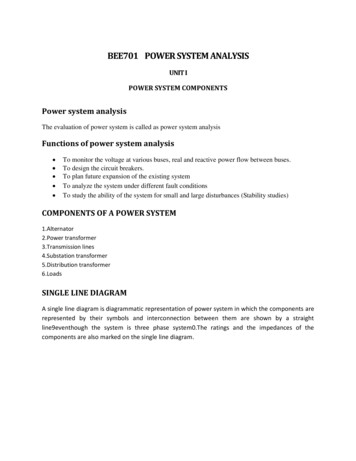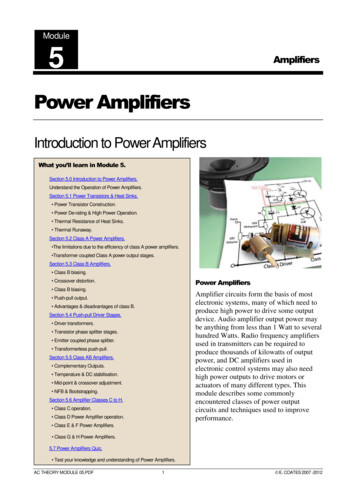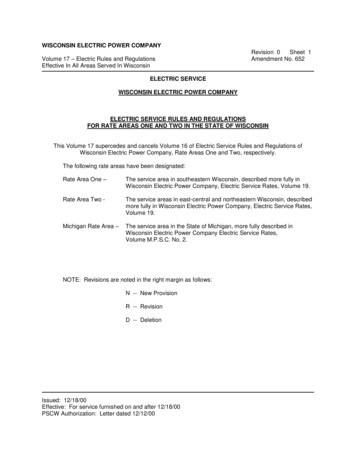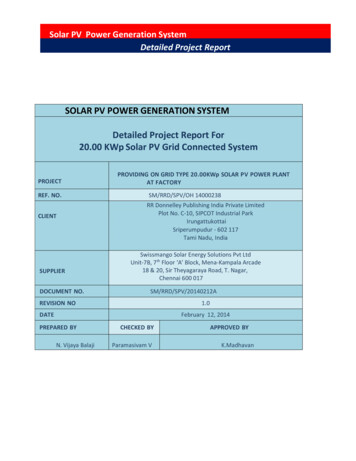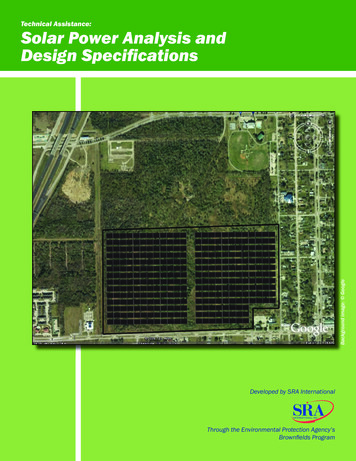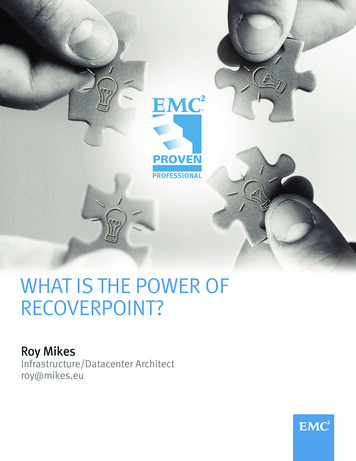
Transcription
WHAT IS THE POWER OFRECOVERPOINT?Roy MikesInfrastructure/Datacenter Architectroy@mikes.eu
Table of ContentsAbout This Article3Who Should Read This Article?3Introduction4Why we need replication6Data Protection Technologies8Backup8Snapshots8Continuous data protection9What is RecoverPoint?Splitter1113Management15VMware Site Recovery Manager18Storage Replication Adapter18Developing a Recovery Strategy20How it works21Consistency GroupsPolicy2121VMware SRM Protection Groups23VMware SRM Recovery Plan25Run a Recovery Plan26AppSync28Conclusion30References32Disclaimer: The views, processes, or methodologies published in this article are those of theauthor. They do not necessarily reflect EMC Corporation’s views, processes, ormethodologies.2014 EMC Proven Professional Knowledge Sharing2
About This ArticleToday’s businesses face an ever-increasing amount of data that threatens to undermine theirexisting storage management solutions. Data protection is no longer the simple copying ofyesterday’s changes. Critical data changes instantly, and to protect this data we arefrequently reaching to new technologies. The EMC RecoverPoint product family provides acomprehensive data protection solution for mainly enterprise customers, providing integratedcontinuous data protection and continuous remote replication to recover applications to anypoint in time.This article will help you understand the need for replication performed by RecoverPoint.Because it is not all technical, this article covers also the non-technical discussions.As such, this material is probably most useful to those with little or no familiarity with thistopic. Readers who fall into this category would be well served to read this article.Who Should Read This Article?This article is written for IT professionals who are responsible for managing and defining thedirection of protecting data in their data center(s).These include: Storage Administrators Operational, middle level managers IT managers (CIO, Chief information officer)Organizations and individuals who have the same interests will benefit from this article aswell. My goal is to give a general guideline to provide insight into Replication and Recovery,which should not be too difficult to read.2014 EMC Proven Professional Knowledge Sharing3
IntroductionThough certainly not a new product, I recently finished an EMC RecoverPoint configuration.After installation, configuration, and a recovery test I was amazed by the great potential ofthis appliance/software. RecoverPoint makes it easier to protect applications that grow,providing a wizard that allows you to modify the applications’ protection configuration to addnew storage volumes. According to EMC, you'll never have to worry about data protectionagain. As far as I can judge now, this is 100% true.What Is the Power of RecoverPoint?RecoverPoint systems enable reliable data replication over any distance within the same site(CDP), to another distant site (CRR), or both concurrently (CLR). Specifically, RecoverPointsystems support data replication that applications are writing over Fibre Channel to localSAN-attached storage. The systems use existing Fiber Channel infrastructure to integrateseamlessly with existing host applications and data storage subsystems. For remotereplication, the systems use existing IP connections to send the replicated data over a WAN,or use Fiber Channel infrastructure to replicate data asynchronously or synchronously. Thesystems provide failover of operations to a secondary site in the event of a disaster at theprimary site.Similar to other continuous data protection products, and unlike backup products,RecoverPoint needs to obtain a copy of every write in order to track data changes.RecoverPoint supports three methods or write splitting: host-based, fabric-based, and in thestorage array. EMC advertises RecoverPoint as heterogeneous due to its support of multivendor server, network, and storage environments.Each site requires installation of a cluster that holds a minimum of two RecoverPointappliances for redundancy. Each appliance is connected via Fiber Channel to the SAN, andmust be zoned together with both the server and the storage. Each appliance must also beconnected to an IP network for management. All replication takes place over standard IP forasynchronous replication and Fiber Channel for synchronous replication.Beyond integration with EMC products such as the CLARiiON , VNX , VMAX storagearrays, Replication Manager and EMC Control Center , RecoverPoint integrates withVMware vCenter and Microsoft Hyper-V, enabling protection to be specified per virtualmachine instead of per volumes that are available. It also integrates with Microsoft ShadowCopy, Exchange, SQL Server, and Oracle Database Server which enables RecoverPoint totemporarily stop writes by the host in order to take consistent application-specific snapshots.2014 EMC Proven Professional Knowledge Sharing4
EMC RecoverPoint’s concurrent local and remote (CLR) data protection technologyeliminates the need for separate solutions as it provides CDP and CRR of the same data.The solution now provides more flexibility to replicate and protect data in many local andremote-site combinations with less storage footprint whether for production applications or fortest and development.Despite the simple looks and the lots of 'sounds goods', you really have to know what youare doing with this application. It can be confusing because of the many possibilities.Therefore, you should be careful what you do.2014 EMC Proven Professional Knowledge Sharing5
Why we need replicationData replication is the same data stored on multiple storage arrays. Besides people, the mostvaluable asset is your business data. Without people to maintain the equipment, even themost sophisticated and powerful machinery would cease to function. Without people doingthe day-to-day operations, the organization would stop functioning. On the one hand, weneed people. On the other side, technique is needed to protect against disasters such asdata loss. My previous[1] Proven Professional Knowledge Sharing article discussed DisasterRecovery at a high level. I encourage you to read it as it is a good complement to this topic.Data replication is an increasingly important topic these days as more and more databasesare deployed. One of the challenges in database replication is to introduce replication withoutrestricting performance. This can be very difficult in large environments.Implementing remote site protection for critical business information is not a simpleproposition. The first step, even before analyzing technology, is to understand the currentbusiness processes and develop a clear set of objectives and plans that reflect what isrequired to safeguard against disasters that could make data at the primary site unavailable.Before applications are transferred to production, design of a protection solution must becompleted. In fact, this should be mandatory. Ask yourself what will be left, if the productionsite goes offline due to a disaster and the business processes on the primary site becomesunavailable or even lost. To prevent this kind of scenario, data has to be transferred to arecovery site.Another interesting approach is how much data loss can be tolerated before the business isdeemed unable to restart production? This is termed the recovery point objective (RPO),which is “ the maximum tolerable period in which data might be lost”. For critical businessapplications, such as real-time financial transactions, businesses cannot afford to lose anydata in the event of a disaster. In this case, their RPO must be zero. For most businessapplications, the loss of a few minutes to a few hours of data can be easily tolerated, andtheir RPO is much more flexible.Once the RPO requirements are well understood, the second challenge is how long it takesto restart the business applications at the recovery site with the data at the remote site. Thismeasurement is termed the recovery time objective (RTO). In the case of real-time financialtransactions, it may be very important that the application comes back online in a matter ofseconds without any noticeable impact to the end users. For other applications, a delay of afew minutes or hours may be tolerable.2014 EMC Proven Professional Knowledge Sharing6
It is reasonable to assume that the shorter the RTO and the RPO, the more difficult or costlyit may be to successfully implement a disaster recovery process. A perfect configuration thatguarantees no data loss and data that is instantly available may come at a complexity andprice that often are not practical. Therefore, it is important to distinguish between absolutelycritical business applications and other applications.Impact versus investment2014 EMC Proven Professional Knowledge Sharing7
Data Protection TechnologiesData protection has evolved over time and became more important. In the early years, mostcomputer systems were stand-alone, with their entire data residing on one single system.Networking and interconnectivity between systems were expensive and limited. Yet, therewas a need to protect this data that resided on these systems. Out of this need arose thecapability to back up data to tape. Tape was the prevalent interchange media for data, andevery major system had one or more tape drives. As applications evolved, so did the backuptechnology. This is not altered by time. Applications become more complex and data isgrowing. It’s logical that these technologies evolve too, and are interrelated.A reasonable question is: How do you choose the right replication method for optimal dataprotection? However, the right question is: How important is your data? Answering thisquestion isn’t easy because how do you measure importance?BackupThe simplest form of replication is Backup. A backup is a copy of data from your files ordatabase that can be used to reconstruct that data. Backups can be divided into physicalbackups and logical backups. I assume noexplanation is needed on the idea behind backupvia tape or disk. However, there are severalspecific backup methods for backup solutions forMicrosoft, such as SQL, Exchange, orSharePoint. Or backup solutions for Oracle. Let’salso not forget VMware. What about Desktops,Laptops, or Remote Office Solutions or DisasterRecovery, and so on? As you can see, there’s alot to consider and each application has itspeculiarities.SnapshotsOn the heels of backup came the concept of snapshots. A snapshot is a copy of a filesystem, volume, or LUN that contains an image of the data as it appeared at the time whenthe copy was initiated. The snapshot may either duplicate or replicate the data it represents.Snapshot technology can be implemented on the host, in the storage network, or at the arraylevel. Host-based snapshots may be performed at the volume level as in the Veritas VolumeManager Snapshot facility, or at the file system level as in Microsoft’s Volume Shadow Copy2014 EMC Proven Professional Knowledge Sharing8
Services (VSS). When implemented inside of any array, most snapshots are at the physical,or block level.A snapshot may be a full copy of a LUN, or it may be a replicate snapshot, which justcontains the changes necessary to apply to the current version of the LUN to re-create theimage at a specific point in time.Snapshots tend to be less disruptive to applications and environment. Remember that whena snapshot is taken there still can be data in memory. Make sure you flush this data to diskwhen you need an absolute consistent snapshot.Snapshot technology can be host-based,network-based, or array-based. Host- andnetwork-based technologies tend to be moregeneric, and less dependent upon a specificarray vendor’s storage. Meanwhile arraybased technology is usually tied to thevendor’s storage product and may havelimitations, such as it can only supportsnapshots using resources available insidethe array.Host- or network-based products tend to have fewer of these limitations, as they build onresources presented to them from the underlying storage infrastructure. For example, theVeritas Volume Manager Snapshot facility creates an exact copy of a primary volume at aparticular instance in time. After a snapshot is taken, it can be accessed independent of thevolume from which it was taken.Regardless of the implementation, snapshots are less disruptive, more reliable, and fasterthan traditional backup. It’s worth noting that snapshots can consume significant resources.Continuous data protectionA continuous data protection product is designed to monitor changes to one or more dataobjects and store a copy of these changes in a journal. This journal can then be used to recreate the object as it existed at any previous point in time. A CDP product is either filesystem-centric, where the object is a file, or storage block-centric, where the object is theLUN.2014 EMC Proven Professional Knowledge Sharing9
File system CDP products are typically found in Microsoft Windows environments, andusually offer a file system. Block-based CDP operates as a layered feature of the underlyingstorage infrastructure, and usually operates independent of the host’s file system and volumemanager.A CDP system also enables the user to establish write consistency between two or moreobjects that reside on different systems. For example, a database has two different objects—the files that maintain the database’s data, and the files that maintain the database’s logs. Alldatabases will write to the log files before they commit the write to the data files. If a CDPproduct did not enforce write consistency between the two, a restoration of previous versionsof the data and log files could result in a corrupted database. In this example, theadministrator would identify the data and log files as part of the same consistency groupingto ensure that write order between the data and log files is maintained.It is important to note that CDP systems deliver what is known as an “atomic” view of thedata. All the data across all the disks is shown at exactly the same moment in time. It is as iftime stopped at that exact moment. This atomic view provides consistency and stabilityacross databases, applications, federations, and even entire data centers. CDP candynamically re-create entire application environments without application involvement. Infact, the alternate view staging can be done on a completely different SAN or even in aseparate geographic location.2014 EMC Proven Professional Knowledge Sharing10
What is RecoverPoint?EMC RecoverPoint[2] is a single solution that provides the advantages of host-based andarray-based solutions while replicating data from any SAN-based array to any other SANbased array over existing Fibre Channel or IP networks using any combination of hostbased, VNX -based, or intelligent fabric-based write-splitting options. RecoverPoint is aproduct variant that is optimized for VNX series storage arrays.Both RecoverPoint and RecoverPoint/SE provide synchronous local replication usingcontinuous data protection (CDP), synchronous and asynchronous continuous remotereplication (CRR), and concurrent local and remote (CLR) data protection. The RecoverPointfamily protects companies from data loss due to common problems such as server failures,data corruption, software errors, viruses, and end-user errors, while also protecting againstcatastrophic events that can bring an entire data center to a standstill.The RecoverPoint family supports application bookmarks, instantaneous recovery, and bidirectional local and remote replication. RecoverPoint provides point-in-time DVR-likerecovery, and its unique clustered architecture provides linear scalability to support the mostdemanding environments. RecoverPoint support for heterogeneous storage, hosts, networks,and SANs enables storage investment protection, enhances business continuity, andfacilitates storage consolidation.RecoverPoint application software runs on an EMC-provided and -supported appliance thatprovides the core functionality and management for the system. The RecoverPoint applianceis built from a standard Dell 1μ high-availability server running a customized 64-bit Linux 2.6kernel. Appliances are sold and deployed in a two- to eight-node cluster configuration persite. A RecoverPoint cluster enables active-active failover between the nodes.Each RecoverPoint appliance provides four physical Fiber Channel ports that are autosensing and support 2, 4, and 8 Gbps/s connections. Each RecoverPoint appliance providestwo 1 Gbit Ethernet ports which are used for management and monitoring. The other is usedfor remote replication over the WAN. Hosts and storage arrays are connected to theRecoverPoint appliance using standard Fiber Channel SANs enabling host fan-in and arrayfan-out.Each RecoverPoint cluster can define up to 64 consistency groups per RecoverPointappliance, with all consistency groups transferring data at any one time. A RecoverPointcluster can support up to 128 consistency groups. If one of the appliances fails, theconsistency groups defined to the failed appliance will be temporarily transferred to the2014 EMC Proven Professional Knowledge Sharing11
remaining appliances, and data transfer will continue. Once the appliance is repaired, theconsistency groups will be transferred back to their original appliance.RecoverPoint can support up to 2,048 replication sets, with each replication set containingthe production LUN, a local replica LUN, and/or a remote replica LUN. The maximumnumber of LUNs that can be managed is 2,048 production LUNs with 4,096 local and remotereplicas for a total of 6,144 LUNs.RecoverPoint supports EMC and third-party storage by using write-splitting technology. Thefunction of the write splitter is to mirror writes to protected LUNs to the RecoverPointappliance. The host driver is a host-resident lightweight driver residing at the bottom of theI/O stack, just above any existing multi-path software (such as PowerPath ). The EMC VNXsplitter runs on the EMC VNX storage processor and supports write splitting for all of theVNX Fiber Channel and iSCSI volumes.Refer to the EMC Support Matrix for a full list of the storage supported by RecoverPoint.2014 EMC Proven Professional Knowledge Sharing12
SplitterThe magic in RecoverPoint, the Splitter makes a copy of every write I/O and sends it toRecoverPoint (RPAs) for replication, local or remote. To split these writes you need a writesplitter.There are three types of splitters. Host-based that is installed on the host itself just above the multi-path software Fabric-based that is installed within your Fiber Channel fabric switches (Brocade orCisco) Array-based that is installed in FLARE on your array (VNX Only)Note: RecoverPoint provides out-of-band replication and therefore is not involved in the I/Oprocess. This is important because often people suggest this impacts the I/O process butthat is NOT true. Instead, a separate component of RecoverPoint, called the splitter (orKDriver), is involved.The primary function of a splitter is to split or “duplicate” application writes so that they aresent to their normally designated storage volumes and the RPA simultaneously. The splittercarries out this activity efficiently, with little perceptible impact on host performance, since allCPU-intensive processing necessary for replication is performed by the RPA.A splitter is proprietary software that is installed on either host operating systems, intelligentfabric switches, or storage subsystems (see three types above). A host-based splitter resideson a host server that accesses a volume being protected by RecoverPoint. This splitterresides in the I/O stack, below the file system and volume manager layer, and just above themulti-path layer. This splitter operates as a device driver and inspects each write sent downthe I/O stack and determines if the write is destined for o
RecoverPoint needs to obtain a copy of every write in order to track data changes. RecoverPoint supports three methods or write splitting: host-based, fabric-based, and in the storage array. EMC advertises RecoverPoint as heterogeneous



